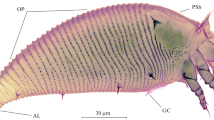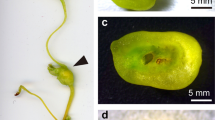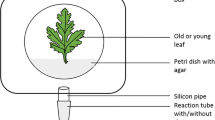Abstract
The gall miteAceria cladophthirus (Nalepa) is able to survice outside its gall on detached leaves ofSolanum dulcamara L. kept under non-aseptic in-vitro conditions. The survival rate of the females on susceptible leaves is about 90% after 1 day and 85% for the following days. In contrast, on resistant leaves, less than 40$ survive after 1 day while necrotic local lesions develop and later the mortality increases severely. However, the mite only completes its life-cycle on susceptible leaves. The life-cycle forA. cladophthirus takes about 12 days: six days for egg incubation and six days for two instars growth. Its life-history is simple, without alternating females specialised for hibernation; arrhenotokous parthenogenesis occurs in experimental conditions. Eggs do not play any role in gall formation. Immature stages induce gall symptoms but are less efficient than females. Mite feeding only induces complete gall symptoms on the less differentiated leaves of susceptible shoots. On susceptible detached leaves, gall symptoms are similar but weaker and their intensity decreases with increasing leaf age; fully expanded leaves remain free of symptoms.
On resistant plants, mite feeding induces a hypersensitive response: necrotic local lesions, about 350 μm in diameter, appear both on shoots and on detached leaves. However, young leaves develop smaller lesions than old ones. Females induce larger lesions than first larvae. Once necrosis formation is initiated, it proceeds to completion regardless of the duration of mite feeding.
Similar content being viewed by others
References
Bailey, J.A., 1982, Mechanisms of phytoalexin accumulation. In: J.A. Bailey and J.W. Mansfield (Editors), Phytoalexins, Blackie, Glasgow/London, pp. 289–318.
Bronner, R. and Westphal, E., 1987 a. Modification des noyaux des cellules épidermiques foliaires de Solanacées soumises à l'action d'un Acarien cécidogène,Eriophyes cladophthirus. In: Proc. ler Congr. Soc. Fr. Phytopathol, 19–20 November 1987, Rennes, France, p. 37.
Bronner, R. and Westphal, E., 1987b. Quelques aspects de la résistance par hypersensibilité deSolanum dulcamara à l'attaque cécidoène d'un Acarien (Eriophyes cladophthirus). In: Proc. ler Congr. Societe Francais de Phytopathologie, 19–20 November 1987, Rennes, France. Ecole Nationale Superieure d'Agronomic, Rennes, p. 84.
Buhr, H. (Editor), 1964. Bestimmungstabellen Gallen and Pflanzen Mittel-u. Nordeuropas. Fischer, Jena, 1573 pp.
Gibson, R.W., 1974. Studies on the feeding behaviour of the eriophyid miteAbararus hystrix, a vector of grass viruses. Ann. Appl. Biol., 78: 213–217.
Hall, C.C., 1967. Eriophyidae of Kansas. Univ. Kans. Sci. Bull., 47: 601–675.
Jeppson, L. R., Keifer, H.H. and Baker, E.W., (Editors), 1975. Mites Injurious to Economic Plants. Univ. California Press, Berkeley, 614 pp.
Keifer, H.H., 1942. Enophyid Studies XII (Experiments proving structural deuterogyny). Bull. Calif. Dep. Agric., 31: 117.
Keifer, H.H., 1959. Eriophyid studies, XXVI. Bull. Calif. Dep. Agric., 47: 278–281.
Keifer, H.H., Baker, E.W., Kono, T., Delfinado, M. and Styer, W.E., (Editors), 1982. An Illustrated Guide to Plant Abnormalities caused by Eriophyid Mites in North America. USDA, Agric. Res. Serv., Agric. Handb. No. 573, 178 pp.
Krantz, G.W., 1973. Observations on the morphology and behaviour of the filbert rust miteAculus comatus (Prostigmata: Eriophyoidea) in Oregon. Ann. Entomol. Soc. Am., 66: 706–717.
Murashige, T. and Skoog, F., 1962. A revised medium for rapid growth and bioassay with tobacco cultures. Physiol. Plant. 15: 473–497.
Nalepa, A., 1911. Eriophyiden, Gallmilben. Zoologica XXIV, 61: 166–293.
Neměc, B., 1924. Untersuchung über Eriophyidengallen. Studies from the Plant Physiological Laboratory of Charles University, Prague, V. 2: 47–94.
Oldfield, G.N., Hobza, R.F. and Wilson, N.S., 1970. Discovery and characterization of spermatophores in the eriphyoidea (Acari). Ann. Entomol. Soc. Am., 63: 520–526.
Putman, W.L., 1939. The plum nursey mite (Phyllocoptes fockeui N. and T.). Ann. Rep. Entomol. Soc. Ont., 7: 33.
Schevtchenko, V.G., 1957. The life history of alder gall mite,Eriophyes laevi (Nal.). Zool. J., 36: 598–618.
Slykhuis, J.T., 1967. Methods for experimenting with mite transmission of plant viruses. In: Methods in Virology, 1. Academic Press, New York, pp. 347–368.
Sternlicht, M. and Goldenberg, S., 1971. Fertilization, sex ratio, and postembryonic stages of the citrus bud mite,Aceria sheldoni (Ewing). Bull. Entomol. Res., 60: 391–397.
Thomsen, J., 1975. Development and histology of galls onTilia plathyphylla caused byEriophyes tiliae tiliae. Bot. Tidsskr., 69: 262–270.
Westphal, E., 1977. Morphogenèse, ulstrastructure et étiologie de quelques galles d'Eriophyides (Acariens). Marcellia, 39: 193–375.
Westphal, E., 1980) Response of some Solanaceae to attack by the gall miteEriophyes cladophthirus. Plant Dis., 64: 406–409.
Westphal, E., Bronner, R. and Le Ret, M., 1981. Changes in leaves of suceptible and resistantSolanum dulcamara infested by the gall miteEriophyes cladophthirus (Acarina, Eriophyoidea). Can. J. Bot., 59: 875–882.
Westphal, E., Bronner, R., Dreger, F. and Anthony, M., 1988a. Relations hôte-parasite entre un AcarienEriophyes cladophthirus Nal. et différentes variétés de pommes de terre. Proc. 6th Int. Conf. Pests in Argriculture, 1–3 December 1988, Paris, France. Association National de Protection des Plantes, pp. 559–602.
Westphal, E., Bronner, R., Dreger, F. and Anthony, M., 1988b. Variabilité des réponses des pommes de terre à l'agression d'un Acarien,Aceria cladophthirus. In: Proc. 113th Congr. National des Sociétés Savantes, 5–9 April, Strasbourg, France, (in press).
Author information
Authors and Affiliations
Rights and permissions
About this article
Cite this article
Westphat, E., Dreger, F. & Bronner, R. The gall miteAceria cladophthirus. I. Life-cycle, survival outside the gall and symptoms' expression on susceptible or resistantSolanum dulcamara plants. Exp Appl Acarol 9, 183–200 (1990). https://doi.org/10.1007/BF01193428
Accepted:
Issue Date:
DOI: https://doi.org/10.1007/BF01193428




